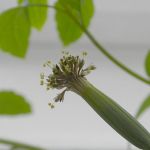| Common Name: |
Poreleaf |
| Other Names: |
Papalo, Papaloquelite |
| Botanical Name: |
Porophyllum ruderale |
| Genus: |
Porophlllum |
| Family: |
Asteracea |
| Native Location: |
S and C America and the Caribbean islands. |
| Cultivation: |
Well-drained soil in sun. Self-sows freely in suitable conditions. |
| Propagation: |
By seed sown in spring at 21°C (70°F) |
| Harvest: |
Leaves are picked as required and used fresh. |
| Height: |
1.5-2m (5-6ft) |
| Hardiness: |
Z10-11 |
| Parts Used: |
Leaves |
| Properties: |
A bitter, strongly aromatic herb with a cilantro-like flavor. |
| Culinary Uses: |
Chopped leaves are added to salads, salsa, guacamole, and other Mexican dishes; also as a substitute for cilantro in any recipe. |
| Bibliography: |
Encyclopedia of Herbs by Deni Brown Copyright © 1995, 2001 Dorling Kindersley Limited. Pp. 328-329 |

